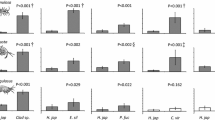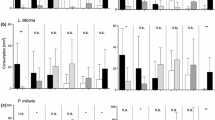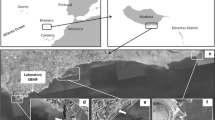Abstract
The consequences of plant introductions into ecosystems are frequently reported from terrestrial environments, but little is known about the effects on ecosystem functioning caused by non-native primary producers in marine systems. In this study we explored the effects of the invasion by the two filamentous red algae Heterosiphonia japonica and Bonnemaisonia hamifera on the primary production of seaweed communities by using single and mixed cultures of non-native and native red algae. The experiments were conducted both in the presence and absence of herbivores. Biomass production of the invaded community increased more than four times in mixed cultures with H. japonica, while introduction by B. hamifera had no significant effect. The different impact on community production could be explained by differences in life history strategies between the invaders; H. japonica grew considerably faster than the native seaweeds which directly increased the community production, while B. hamifera showed a relatively slow growth rate and therefore had no effect. From previous studies it is known that B. hamifera produces a highly deterrent, but also costly, chemical defence. The assessment of survival and growth of a native generalist herbivore further corroborated that the biomass produced by B. hamifera constitutes a very low-quality food, whereas the performance of herbivores on a diet of H. japonica was comparable to that on native algal diets. In summary, this study demonstrates that successful invaders belonging to the same functional group (filamentous red algae) may have distinctly different impacts on productivity in the recipient community, depending on their specific life history traits.


Similar content being viewed by others
References
Abramoff MD, Magalhaes P, Ram S (2004) Image processing with ImageJ. Biophotonics Int 11:36–42
Bekkby T, Moy FE (2011) Developing spatial models of sugar kelp (Saccharina latissima) potential distribution under natural conditions and areas of its disappearance in Skagerrak. Estuar Coast Shelf Sci 95:477–483. doi:10.1016/j.ecss.2011.10.029
Bjærke MR, Rueness J (2004) Effects of temperature and salinity on growth, reproduction and survival in the introduced red alga Heterosiphonia japonica (Ceramiales, Rhodophyta). Bot Mar 47:373. doi:10.1515/BOT.2004.055
Blossey B, Notzold R (1995) Evolution of increased competitive ability in invasive nonindigenous plants—a hypothesis. J Ecol 83:887–889
Boudouresque CF, Lemée R, Mari X, Meinesz A (1996) The invasive alga Caulerpa taxifolia is not a suitable diet for the sea urchin Paracentrotus lividus. Aquat Bot 53:245–250
Breeman AM, Meulenhoff EJS, Guiry MD (1988) Life history regulation and phenology of the red alga Bonnemaisonia hamifera. Helgol Meeresunters 42:535–551. doi:10.1007/BF02365625
Bruno JF, Boyer KE, Duffy JE et al (2005) Effects of macroalgal species identity and richness on primary production in benthic marine communities. Ecol Lett 8:1165–1174. doi:10.1111/j.1461-0248.2005.00823.x
Bruno JF, Lee SC, Kertesz JS et al (2006) Partitioning the effects of algal species identity and richness on benthic marine primary production. Oikos 115:170–178. doi:10.1111/j.2006.0030-1299.14927.x
Callaway RM, Ridenour WM (2004) Novel weapons: invasive success and the evolution of increased competitive ability. Front Ecol Environ 2:436–443. doi:10.1890/1540-9295
Cappuccino N, Carpenter D (2005) Invasive exotic plants suffer less herbivory than non-invasive exotic plants. Biol Lett 1:435–438. doi:10.1098/rsbl.2005.0341
Cardinale BJ, Srivastava DS, Duffy JE et al (2006) Effects of biodiversity on the functioning of trophic groups and ecosystems. Nature 443:989–992. doi:10.1038/nature05202
D’Antonio CM, Vitousek PM (1992) Biological invasions by exotic grasses, the grass/fire cycle, and global change. Annu Rev Ecol Syst 23:63–87
Ehrenfeld JG (2003) Effects of exotic plant invasions on soil nutrient cycling processes. Ecosystems 6:503–523. doi:10.1007/s10021-002-0151-3
Ehrenfeld JG (2010) Ecosystem consequences of biological invasions. Annu Rev Ecol Evol Syst 41:59–80. doi:10.1146/annurev-ecolsys-102209-144650
Eklund B, Svensson AP, Jonsson C, Malm T (2005) Toxic effects of decomposing red algae on littoral organisms. Estuar Coast Shelf Sci 62:621–626. doi:10.1016/j.ecss.2004.09.030
Enge S, Nylund GM, Harder T, Pavia H (2012) An exotic chemical weapon explains low herbivore damage in an invasive alga. Ecology 93:2736–2745. doi:10.1890/12-0143.1
Enge S, Nylund GM, Pavia H (2013) Native generalist herbivores promote invasion of a chemically defended seaweed via refuge-mediated apparent competition. Ecol Lett 16:487–492. doi:10.1111/ele.12072
Forslund H, Wikström SA, Pavia H (2010) Higher resistance to herbivory in introduced compared to native populations of a seaweed. Oecologia 164:833–840. doi:10.1007/s00442-010-1767-1
Francour P, Harmelin-Vivien M, Harmelin JG, Duclerc J (1995) Impact of Caulerpa taxifolia colonization on the littoral ichthyofauna of north-western Mediterranean sea: preliminary results. Hydrobiologia 300:345–353. doi:10.1007/BF00024475
Griffin JN, Méndez V, Johnson AF et al (2009) Functional diversity predicts overyielding effect of species combination on primary productivity. Oikos 118:37–44. doi:10.1111/j.1600-0706.2008.16960.x
Grotkopp E, Rejmánek M, Rost TL (2002) Toward a causal explanation of plant invasiveness: seedling growth and life-history strategies of 29 pine (Pinus) species. Am Nat 159:396–419. doi:10.1086/338995
Herberich E, Sikorski J, Hothorn T (2010) A robust procedure for comparing multiple means under heteroscedasticity in unbalanced designs. PLoS One 5:e9788. doi:10.1371/journal.pone.0009788
Hladyz S, Abjornsson K, Giller PS, Woodward G (2011) Impacts of an aggressive riparian invader on community structure and ecosystem functioning in stream food webs. J Appl Ecol 48:443–452. doi:10.1111/j.1365-2664.2010.01924.x
Hothorn T, Bretz F, Westfall P (2008) Simultaneous inference in general parametric models. Biom J 50:346–363. doi:10.1002/bimj.200810425
Hulme PE, Bacher S, Kenis M et al (2008) Grasping at the routes of biological invasions: a framework for integrating pathways into policy. J Appl Ecol 45:403–414. doi:10.1111/j.1365-2664.2007.01442.x
Husa V, Sjøtun K (2006) Vegetative reproduction in Heterosiphonia japonica (Dasyaceae, Ceramiales, Rhodophyta), an introduced red alga on European coasts. Bot Mar 49:191–199. doi:10.1515/BOT.2006.024
Husa V, Sjøtun K, Lein TE (2004) The newly introduced species Heterosiphonia japonica Yendo (Dasyaceae, Rhodophyta): geographical distribution and abundance at the Norwegian southwest coast. Sarsia 89:211–217. doi:10.1080/00364820410006600
Karlsson J (2007) Övervakning av vegetationsklädda hårdbottnar vid svenska västkusten 1993–2006. Göteborgs Universitet
Keane RM, Crawley MJ (2002) Exotic plant invasions and the enemy release hypothesis. Trends Ecol Evol 17:164–170. doi:10.1016/S0169-5347(02)02499-0
Lavorel S, Garnier E (2002) Predicting changes in community composition and ecosystem functioning from plant traits: revisiting the Holy Grail. Funct Ecol 16:545–556. doi:10.1046/j.1365-2435.2002.00664.x
Levine JM, Vilà M, D’Antonio CM et al (2003) Mechanisms underlying the impacts of exotic plant invasions. Proc R Soc Lond B 270:775–781. doi:10.1098/rspb.2003.2327
Liao C, Peng R, Luo Y et al (2008) Altered ecosystem carbon and nitrogen cycles by plant invasion: a meta-analysis. New Phytol 177:706–714. doi:10.1111/j.1469-8137.2007.02290.x
Loreau M (1998) Separating sampling and other effects in biodiversity experiments. Oikos 82:600–602
Maggs CA, Stegenga H (1998) Red algal exotics on North Sea coasts. Helgol Meeresunters 52:243–258. doi:10.1007/BF02908900
Moy FE, Christie H (2012) Large-scale shift from sugar kelp (Saccharina latissima) to ephemeral algae along the south and west coast of Norway. Mar Biol Res 8:309–321. doi:10.1080/17451000.2011.637561
Nash R, Rindi F, Guiry MD (2005) Optimum conditions for cultivation of the Trailliella phase of Bonnemaisonia hamifera Hariot (Bonnemaisoniales, Rhodophyta), a candidate species for secondary metabolite production. Bot Mar 48:257–265. doi:10.1515/BOT.2005.035
Nyberg CD, Wallentinus I (2005) Can species traits be used to predict marine macroalgal introductions? Biol Invasions 7:265–279. doi:10.1007/s10530-004-0738-z
Paul VJ, Arthur KE, Ritson-Williams R et al (2007) Chemical defenses: from compounds to communities. Biol Bull 213:226–251
Pavia H, Carr H, Åberg P (1999) Habitat and feeding preferences of crustacean mesoherbivores inhabiting the brown seaweed Ascophyllum nodosum(L.) Le Jol. and its epiphytic macroalgae. J Exp Mar Biol Ecol 236:15–32. doi:10.1016/S0022-0981(98)00191-9
Pavia H, Baumgartner F, Cervin G et al (2012) Chemical defences against herbivores. In: Brönmark C, Hansson LA (eds) Chemical ecology in aquatic systems. Oxford university press, New York, pp 210–229
Petchey OL (2003) Integrating methods that investigate how complementarity influences ecosystem functioning. Oikos 101:323–330. doi:10.1034/j.1600-0706.2003.11828.x
Poore AGB, Campbell AH, Coleman RA et al (2012) Global patterns in the impact of marine herbivores on benthic primary producers. Ecol Lett 15:912–922. doi:10.1111/j.1461-0248.2012.01804.x
Purrington CB (2000) Costs of resistance. Curr Opin Plant Biol 3:305–308. doi:10.1016/S1369-5266(00)00085-6
R Core Team (2012) R: a language and environment for statistical computing. R Foundation for Statistical Computing, Vienna
Russell DJ (1992) The ecological invasion of Hawaiian reefs by two marine red algae, Acantophora spicifera (Vahl) Boerg. and Hypnea musciformis (Wulfen) J. Ag., and their association with two native species, Laurencia nidifica J. Ag. and Hypnea cervicornis J. Ag. ICES Mar Sci Symp 194:110–125
Schaffelke B, Hewitt C (2007) Impacts of introduced seaweeds. Bot Mar 50:397–417. doi:10.1515/BOT.2007.044
Sjøtun K, Husa V, Peña V (2008) Present distribution and possible vectors of introductions of the alga Heterosiphonia japonica (Ceramiales, Rhodophyta) in Europe. Aquat Invasions 3:377–394. doi:10.3391/ai.2008.3.4.3
Stachowicz JJ, Graham M, Bracken MES, Szoboszlai AI (2008) Diversity enhances cover and stability of seaweed assemblages: the role of heterogeneity and time. Ecology 89:3008–3019. doi:10.1890/07-1873.1
Svensson JR, Nylund GM, Cervin G et al (2013) Novel chemical weapon of an exotic macroalga inhibits recruitment of native competitors in the invaded range. J Ecol 101:140–148. doi:10.1111/1365-2745.12028
Thomsen MS, Wernberg T, Staeaehr P et al (2007) Alien macroalgae in Denmark—a broad-scale national perspective. Mar Biol Res 3:61–72. doi:10.1080/17451000701213413
Van Kleunen M, Weber E, Fischer M (2010) A meta-analysis of trait differences between invasive and non-invasive plant species. Ecol Lett 13:235–245. doi:10.1111/j.1461-0248.2009.01418.x
Verhoeven KJF, Biere A, Harvey JA, Van Der Putten WH (2009) Plant invaders and their novel natural enemies: who is naïve? Ecol Lett 12:107–117. doi:10.1111/j.1461-0248.2008.01248.x
Vilà M, Weiner J (2004) Are invasive plant species better competitors than native plant species? evidence from pair-wise experiments. Oikos 105:229–238. doi:10.1111/j.0030-1299.2004.12682.x
Vilà M, Espinar JL, Hejda M et al (2011) Ecological impacts of invasive alien plants: a meta-analysis of their effects on species, communities and ecosystems. Ecol Lett 14:702–708. doi:10.1111/j.1461-0248.2011.01628.x
White LF, Shurin JB (2011) Density dependent effects of an exotic marine macroalga on native community diversity. J Exp Mar Biol Ecol 405:111–119. doi:10.1016/j.jembe.2011.05.024
Wikström SA, Steinarsdóttir MB, Kautsky L, Pavia H (2006) Increased chemical resistance explains low herbivore colonization of introduced seaweed. Oecologia 148:593–601. doi:10.1007/s00442-006-0407-2
Wilsey BJ, Polley HW (2006) Aboveground productivity and root–shoot alocation differ between native and introduced grass species. Oecologia 150:300–309. doi:10.1007/s00442-006-0515-z
Wilsey BJ, Teaschner TB, Daneshgar PP et al (2009) Biodiversity maintenance mechanisms differ between native and novel exotic-dominated communities. Ecol Lett 12:432–442. doi:10.1111/j.1461-0248.2009.01298.x
Wright IJ, Reich PB, Westoby M et al (2004) The worldwide leaf economics spectrum. Nature 428:821–827. doi:10.1038/nature02403
Acknowledgments
We thank G. Cervin, R. Svensson and F. Baumgartner for field assistance and P. Jonsson for advice on analysis of diversity effects. We also want to thank the staff at the Tjärnö Laboratory (Sven Lovén Centre for Marine Sciences) for practical assistance and two anonymous reviewers for comments that improved the manuscript. The work was performed within the Linnaeus Centre for Marine Evolutionary Biology (http://www.cemeb.science.gu.se/), and the Centre for Marine Chemical Ecology (http://www.cemace.science.gu.se/), at the University of Gothenburg and funded by the Swedish Research Council Formas (contract no. 217-2007-534 to S. A. W.) and a Linnaeus grant from the Swedish Research Council VR (contract no. 621-2011-5630 to H. P.).
Author information
Authors and Affiliations
Corresponding author
Additional information
Communicated by Elena Litchman.
Rights and permissions
About this article
Cite this article
Sagerman, J., Enge, S., Pavia, H. et al. Divergent ecological strategies determine different impacts on community production by two successful non-native seaweeds. Oecologia 175, 937–946 (2014). https://doi.org/10.1007/s00442-014-2938-2
Received:
Accepted:
Published:
Issue Date:
DOI: https://doi.org/10.1007/s00442-014-2938-2




